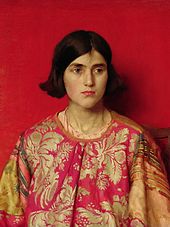Thomas Cooper Gotch
Thomas Cooper Gotch (born December 10, 1854 in Kettering , Northamptonshire , † May 1, 1931 in Newlyn , Cornwall ) was a British painter of Late Impressionism , later Symbolism and Pre-Raphaelism . He is also an important representative of the Newlyn School , an artist colony of the late 19th and early 20th centuries.
life and work
Thomas Cooper Gotch came from a wealthy, unconventional family from Kettering in Central England, north of London, and was the fourth son of Thomas Henry Gotch. His older brother John Alfred Gotch later became an architect and wrote some works on architecture. After attending the Kettering Grammar School , Thomas Cooper Gotch first worked in his father's shoe store. In 1876 he left his father's business to take up his art studies at Heatherley's Art School . In 1877 he attended the Koninklijke Academie voor Schone Kunsten in Antwerp and enrolled at the Slade School of Fine Art in London in 1878 , where he met Henry Scott Tuke , with whom he would later have a lifelong friendship.
Gotch met his future wife Caroline Burland Yates (1854–1945) at Slade School in 1879. At her instigation, they both visited the fishing village of Newlyn in Cornwall with Henry Scott Tuke . In 1881 Gotch and Yates returned to Newlyn to be married at St Peter's Church there. Then both continued their art studies in Paris at the Académie Julian , where Gotch was also taught by Jean Paul Laurens . In 1882 daughter Phyllis Marian Gotch was born in Paris. Parents and children traveled to Australia and took up residence there in Melbourne . On her return to England Gotch participated in the resistance against the conservative understanding of art of the Royal Academy of Arts and founded the New English Art Club in 1885 together with John Singer Sargent , Stanhope Forbes , Frank Bramley and others .
In 1887 the young family settled in Newlyn, where Walter Langley and Samuel John Birch founded an artists' colony, the Newlyn School . There Gotch met Henry Scott Tuke and Stanhope Forbes again, who had also joined this group of painters. On site, he helped set up the Newlyn Art Gallery , which would store and display the works of the artist colony, and the Newlyn Industrial Classes , where young people from the area could learn crafts. Gotch founded the Royal British Colonial Society of Artists in 1887 , which he later chaired from 1913 to 1928. During this time, Gotch, like many painters at the Newlyn School, pursued open air painting and created remarkable oil paintings and watercolors in the style of Realism and Late Impressionism .
In 1891 Gotch traveled to Florence with his wife and stayed there until the spring of 1892. This stay in the capital of the Renaissance brought about a radical change in his painting style, which was now based on the Pre-Raphaelites and influenced by Symbolism and Romanticism . At first his serious change in subject and painting style met with rejection. It was only after The Times highlighted his painting The Child Enthroned as an attraction at the Royal Academy Show in 1894 that his work received widespread recognition. Together with Alleluia from 1896, it is now one of the most outstanding works of art of the Victorian era . The painter used his daughter Phyllis as a model for both paintings. In 1896 he received a small gold medal at the International Art Exhibition in Berlin .
Due to his unmistakable style - symbolistic figures and decorative patterns in a static arrangement of the early Renaissance - Thomas Cooper Gotch has now become one of the most famous artists of his time and many well-known galleries bought his works. As early as 1911, a retrospective of his entire oeuvre took place in Newcastle . Gotch also made numerous landscape pictures and book illustrations , but earned his income mainly from portraiture . His preferred portrayal of one or more young girls, for whom the circle of friends of his daughter Phyllis was often the model, was considered to be modern, so that the painter's house became the center of attraction of the area. Phyllis later works as a writer and singer. In the 20s and 30s Gotch turned back to realism.
Thomas Cooper Gotch died in 1931 and was buried in Newlyn, where he lived. In the same year, an exhibition was held in his birthplace, Kettering , in which his life's work was honored. A large part of his works is still in the Alfred East Gallery in Kettering today . Most of his other works still exist and are located in England. A presentation of his work in bound form has not yet been published, only the Alfred East Gallery sells a 32-page booklet about the artist. Manuscripts of his life and work are kept in the Victoria and Albert Museum in London. In 2001 the exhibition TC Gotch: The Last of the Pre-Raphaelites took place at the Royal Cornwall Museum in Truro .
literature
- Pamela Lomax: The Golden Dream: A Biography of Thomas Cooper Gotch , Sansom & Company Ltd. 2007, ISBN 1904537219
Web links
- www.penleehouse.org.uk
- www.artrenewal.org
- cornwallartists.org
- www.neo-romantic.org.uk
- www.tate.org.uk
| personal data | |
|---|---|
| SURNAME | Gotch, Thomas Cooper |
| BRIEF DESCRIPTION | English painter of Late Impressionism and Pre-Raphaelism |
| DATE OF BIRTH | December 10, 1854 |
| PLACE OF BIRTH | Kettering (Northamptonshire) , Northamptonshire |
| DATE OF DEATH | May 1, 1931 |
| Place of death | Newlyn , Cornwall |



